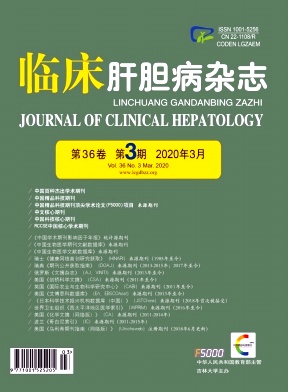|
[1] European Association for the Study of the Liver. EASL clinical practice guidelines:Drug-induced liver injury[J]. J Hepatol,2019,70(6):1222-1261.
|
|
[2] CHURCH RJ,WAT KINS PB. Serum biomarkers of drug-induced liver injury:Current status and future directions[J]. J Dig Dis,2018,20(1):2-10.
|
|
[3] REUBEN A,KOCH DG,LEE WM. Drug-induced acute liver failure:Results of a US multicenter,prospective study[J].Hepatology,2010,52(6):2065-2076.
|
|
[4] SHEN T,LIU YX,SHANG J,et al. Incidence and etiology of drug-induced liver injury in mainland China[J]. Gastroenterology,2019,156(8):2230-2241.
|
|
[5] BJORNSSON ES,BERGMANN OM,BJORNSSON HK,et al.Incidence,presentation,and outcomes in patients with druginduced liver injury in the general population of Iceland[J].Gastroenterology,2013,144(7):1419-1425.
|
|
[6] Drug-induced Liver Disease Study Group,Chinese Society of Hepatology,Chinese Medical Association. Guidelines for the management of drug-induced liver injury[J]. J Clin Hepatol,2015,31(11):1752-1769.(in Chinese)中华医学会肝病学分会药物性肝病学组.药物性肝损伤诊治指南[J].临床肝胆病杂志,2015,31(11):1752-1769.
|
|
[7] CHALASANI N,BONKOVSKY HL,FONTANA R,et al. Features and outcomes of 899 patients with drug-induced liver injury:The DILIN prospective study[J]. Gastroenterology,2015,148(7):1340-1352.
|
|
[8] LUCENA MI,ANDRADE RJ,KAPLOWITZ N,et al. Phenotypic characterization of idiosyncratic drug-induced liver injury:The influence of age and sex[J]. Hepatology,2009,49(6):2001-2009.
|
|
[9] SAADI T,WATERMAN M,YASSIN H,et al. Metformin-induced mixed hepatocellular and cholestatic hepatic injury:Case report and literature review[J]. Int J Gen Med,2013,6:703-706.
|
|
[10] GONZALEZ I,CHATTERJEE D. Histopathological features of drug-induced liver injury secondary to osimertinib[J]. Front Pharmacol,2019,6(2):1093.
|
|
[11] NAIDOO K,HASSAN-MOOSA R,MLOTSHWA P,et al. High rates of drug-induced liver injury in people living with hiv coinfected with tuberculosis(TB)irrespective of antiretroviral therapy timing during antituberculosis treatment:Results from the starting antiretroviral therapy at three points in TB trial[J].Clin Infect Dis,2019,10(17):1537-6591.
|
|
[12] DEV K,SUMITA V. Drug-induced liver injury[J]. Clin Med,2016,16(2):104-109.
|
|
[13] KAPLOWITZ N. Idiosyncratic drug hepatotoxicity[J]. Nat Rev Drug Discov,2005,4(6):489-499.
|
|
[14] RUSSMANN S,JETTER A,KULLAK-UBLICK GA. Pharm acogenetics of drug-induced liver injury[J]. Hepatology,2010,52(2):748-761.
|
|
[15] AHMAD S,AUDREY B,MATTHEW B,et al. Rho-kinase/myosin light chain kinase pathway plays a key role in the impairment of bile canaliculi dynamics induced by cholestatic drugs[J]. Sci Rep,2016,12(6):24709
|
|
[16] RUSSMANN S,KULLAK-UBLICK GA,GRATTAGLIANO I.Current conceps of mechanisms in drug-induced hepatotoxicity[J]. Curr Med Chem,2009,16(23):3041-3053.
|
|
[17] GUENGERICH FP. Mechanisms of drug toxicity and relevance to pharmaceutical development[J]. Eur J Drug Metab Pharmacokinet,2011,26(1):3-14.
|
|
[18] BEGRICHE K,KARIMA J,ROBIN MA,et al. Drug-induced toxicity on mitochondria and lipid metabolism:Mechanistic diversity and deleterious consequences for the liver[J]. Hepatology,2011,54(4):773-794.
|
|
[19] MITCHELL R,MCGILL C,DAVID W,et al. Acetam inopheninduced liver injury in rats and m ice:Comparison of protein adducts,mitochondrial dysfunction,and oxidative stress in the m echanism of toxicity[J]. Toxicol Appl Pharm acol,2012,264(3):387-394.
|
|
[20] CHIPINDA I,HETTICK JM,SIEGEL PD. Haptenation:Chemical reactivity and protein binding[J]. J Allergy(Cairo),2011,2011:839682.
|
|
[21] UETRECHT J. Idiosyncratic drug reactions:Past,present,and future[J]. Chem Res Toxicol,2008,21(1):84-92.
|
|
[22] SATOH H,MARTIN BM,SCHULICK AH,et al. Human antiendoplasmic reticulum antibodies in sera of patients with halothane-induced hepatitis are directed against a trifluoroacetylated carboxylesterase[J]. Proc Natl Acad Sci U S A,1989,86(1):322-326.
|
|
[23] AITHAL GP,RAMSAY L,DALY AK,et al. Hepatic adducts,circulating antibodies,and cytokine polymorphisms in patients with diclofenac hepatotoxicity[J]. Hepatology,2004,39(5):1430-1440.
|
|
[24] JENKINS RE,MENG X,ELLIOTT VL,et al. Characterisation of flucloxacillin and 5-hydroxymethyl flucloxacillin haptenated HAS in vitro and in vivo[J]. Proteomics Clin Appl,2009,3(6):720-729.
|
|
[25] CALLAN HE,JENKINS RE,MAGGS JL,et al. Multiple adduction reactions of nitroso sulfamethoxazole with cysteinyl residues of peptide and proteins:Implications for hapten formation[J]. Chem Res Toxicol,2009,22(5):937-948.
|
|
[26] DALY AK,DONALDSON PT,BHATNAGAR P,et al. HLA-B*5701 genotype is a m ajor determ inant of drug-induced liver injury due to flucloxacillin[J]. Nat Genet,2009,41(7):816-819.
|
|
[27] MONSHI MM,FAULKNER L,GIBSON A,et al. HLA-B*57∶01-restricted activation of drug-specific T cells provides the immunological basis for flucloxacillin-induced liver injury[J]. Hepatology,2013,57(2):727-739.
|
|
[28] CAI Y,YI J,ZHOU C,et al. Pharmacogenetic study of drug-metabolising enzyme polymorphisms on the risk of anti-tuberculosis drug-induced liver injury:A meta-analysis[J].PLo S One,2012,7(10):e47769.
|
|
[29] WANG L,ZHAO XY,MA H. Pathological features of drug-induced liver injury[J]. Chin Hepatol,2017,22(9):837-840.(in Chinese)王岚,赵新颜,马红.药物性肝损伤的病理学特征[J].肝脏,2017,22(9):837-840.
|
|
[30] YU YC,FAN Y,CHENG CW. Criteria of chronic drug-induled liver injury:3 or 6 months or 1 year?[J]. Chin Hepatol,2017,22(2):97-100.(in Chinese)于乐成,范晔,陈成伟.药物性肝损伤慢性化判断标准:3或6个月还是1年?[J].肝脏,2017,22(2):97-100.
|
|
[31] CHALASANI NP,HAYASHI PH,BONKOVSKY HL,et al. ACG clinical guideline:The diagnosis and management of idiosyncratic drug-induced liver injury[J]. Am J Gastroenterol,2014,109(7):950-966.
|
|
[32] DANAN G,BENICHOU C. Causality assessment of adverse reactions to drugs I. A novel method based on the conclusions of international consensus meetings:Application to drug induced liver injuries[J]. Clin Epidemiol,1993,46(11):1323-1330.
|
|
[33] YU YC,FAN Y,CHEN CW. Diagnosis and treatment of druginduced liver injury[J]. J Clin Hepatol,2018,34(6):1160-1165.(in Chinese)于乐成,范晔,陈成伟.药物性肝损伤的诊断和治疗[J].临床肝胆病杂志,2018,34(6):1160-1165.
|
|
[34] LI XF,LIAN JS,WANG YY,et al. The serum metabolomics research of drug induced liver injury based on ultra performance liquid chromatography-mass spectrometry[J]. Chin J Microecol,2013,25(6):625-629,638.(in Chinese)李小芬,连江山,王银银,等.基于超高效液相色谱质谱的药物性肝损害患者血清代谢组学研究[J].中国微生态学杂志,2013,25(6):625-629,638.
|
|
[35] KIM JM,RYU SH,KIM S,et al. Pattern recognition analysis For hepatotoxicity induced by acetaminophen using plasma and urinary 1H NMR-based metabolomics in humans[J].Anal Chem,2013,85(23):11326-11334.
|
|
[36] GONZALEZ E,van LIEMPD S,CONDE-VANCELLS J,et al.Serum UPLC-MS/MS metabolic profiling in an experimental model for acute-liver injury reveals potential biomarkers for hepato-toxicity[J]. Metabolomics,2012,8(6):n997-n1011.
|
|
[37] XIONG YH,YANG L,WANG ZT. Gas chromatography masss pectrometry based profiling of serum fatty acidsin acetaminophen-induced liver injured rats[J]. Applied Toxicology,2014,34(2):149-157.(in Chinese)熊以恒,杨琳,王志泰.气相色谱-质谱联用对乙酰氨基酚引起的肝损伤大鼠血清脂肪酸的分析[J].应用毒理学杂志,2014,34(2):149-157.
|
|
[38] GAO Y,CAO Z,YANG X,et al. Proteomic analysis of acetaminophen-induced hepatotoxicity and identification of heme oxygenase 1 as a potential plasma biomarker of liver injury[J]. Proteomics Clin Appl,2017,1(11):1-2.
|
|
[39] KULLAKUBLICK G,RADE RJ,ME RZM,et al. Drug-induced liver injury:Recent advances in diagnosis and risk as sessment[J]. Gut,2017,66(6):1154-1164.
|
|
[40] CHURCHRJ,KULLAK UBLICK GA,AUBRECHT J,et al. Candidate biomarkers for the diagnosis and prognosis of drug-induced liver injury:An international collaborative effort[J].Hepatology,2019,69(2):760-773.
|
|
[41] STEPHANIE PD,JASON A. Review of drug-induced liver injury[J]. J Nurse Practitioners,2015,11(2):270-271.
|
|
[42] HOOFNAGLE JH,SERRANO J,KNOBEN JE,et al. LiverTox:A website on drug-induced liver injury[J]. Hepatology,2013,57(3):873-874.
|







 DownLoad:
DownLoad: